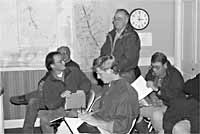County sends St. Luke’s back to the drawing board
Commissioners say they can approve trenching or boring, not both
By TRAVIS PURSER
Express Staff Writer
 From left, Scott O’Meara representing
Power Engineers, a major contractor for St. Luke’s; Department of Water Resources
representative Irv Ballou; St. Luke’s planner John Gaeddert; county engineer Jim
Koonce; Department of Environment Quality representative Terry Blau. (Photo by Willy Cook)
From left, Scott O’Meara representing
Power Engineers, a major contractor for St. Luke’s; Department of Water Resources
representative Irv Ballou; St. Luke’s planner John Gaeddert; county engineer Jim
Koonce; Department of Environment Quality representative Terry Blau. (Photo by Willy Cook)
Contractors for the new St. Luke’s hospital asked for the
"best of both worlds" Monday by applying to the county for a permit to trench
across the Big Wood River, while maintaining an existing permit to bore.
St. Luke’s planner John Gaeddert said the hospital had originally
planned to bore in October "based on two good contracts at the time," but that
the hospital had experienced contractor difficulties since then.
The commissioners, however, expressing discomfort about giving the
hospital a "blank check," said they would not approve the new application to
trench until hospital planners had decided for sure that’s what they would do.
Also, the commissioners said they could not approve the application
because it lacked the necessary input from state regulatory agencies.
The clock is ticking for St. Luke’s, which must have sewer and
water lines installed under the Big Wood River to meet fire department water flow
requirements before combustible construction can begin at the hospital.
Bill Bodnar, St. Luke’s spokesman and vice president for corporate
development, called Monday’s application a "place holder," adding that it
takes a long time to get on the county commissioner’s agenda and that "trenching
would take a minimum of several months for the approval process."
Bodnar and contractors working for St. Luke’s have said the
decision to trench or bore will depend on which method will save the most money and time.
County officials and state representatives have expressed concern,
however, over differences in environmental impact between the two methods.
Commissioner Len Harlig said, "Numbers are important, but not more
important than environmental issues."
Terry Blau, a representative from the Department of Environmental
Quality, said the difference in impact between trenching and boring is "not even
close—we were very happy when the decision was made to bore, not to trench."
Jack Brown, a representative from Sun Valley Water and Sewer, said that
trenching across rivers is a common practice in this state and others and that trenching
would be a suitable method in this case too.
"How much permanent impact has there ever been from boring?"
Brown asked Blau.
Blau said that in the past, open trenching was the only method
available for installing utilities, but "technology is changing."
"Nearly all fiber optic cable is bored under rivers now," he
said.
Robert Flowers, an environmental resource specialist for the Army Corps
of Engineers, agrees that boring will become more and more common in the future due to
improving technology.
During a telephone interview Friday, he said the major advantage of
boring is that it can be done without disturbing the riverbed, shoreline or surrounding
riparian zone.
In fact, he said, if the beginning and ending points of the bore were
located outside the riparian zone and wetlands area, St. Luke’s would not need a
permit from the corps of engineers to perform the work.
On the other hand, he said, trenching will release at least some turbid
water into the river, weaken the riverbed’s natural armoring and disturb highly
visible vegetation along the shoreline.
"We’re searching for the least damaging, practicable
alternative," he said of the various methods of installing the utilities.
As for granting St. Luke’s a permit that would allow them to
either bore or trench, "generally, we would require them to do one or the
other," Flowers said.
One major question Flowers said the Corps of Engineers would have for
St. Luke’s is why they’re not attaching the utilities to one of the two existing
bridges in the area.
That issue was addressed briefly by St. Luke’s planner John
Gaeddert, who said contractors had done extensive research on all available means of
getting the utilities across the river.
Still, Gaeddert said, "at this point, we do not know which way we
are going."
Gaeddert said that decision would likely have to be made Thursday
during a meeting of St. Luke’s administrators.

